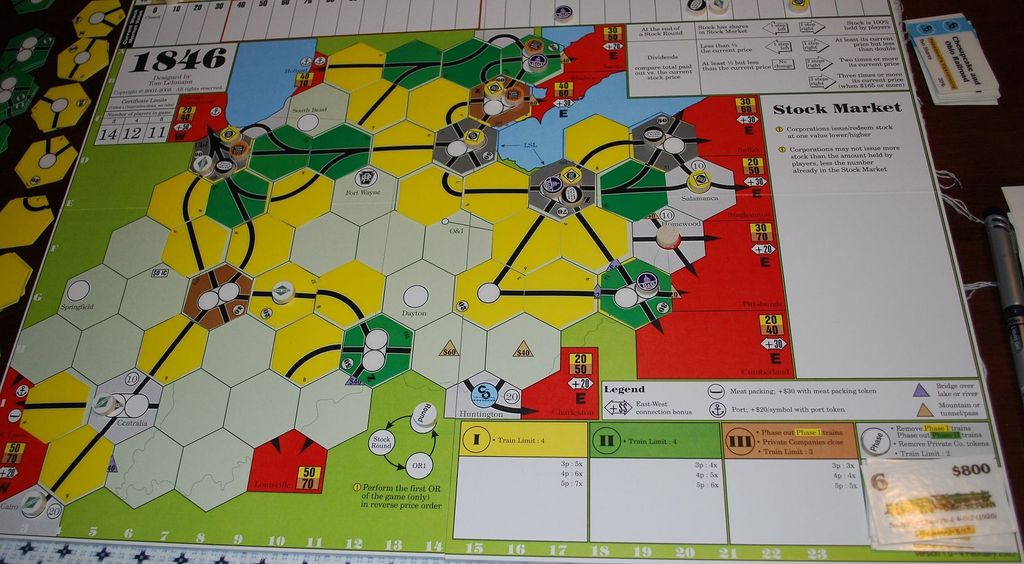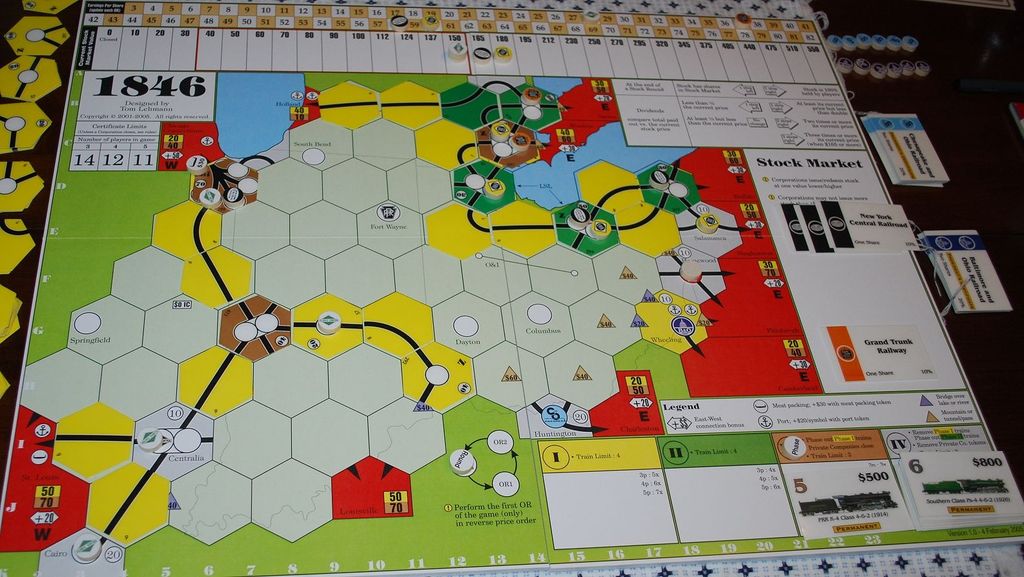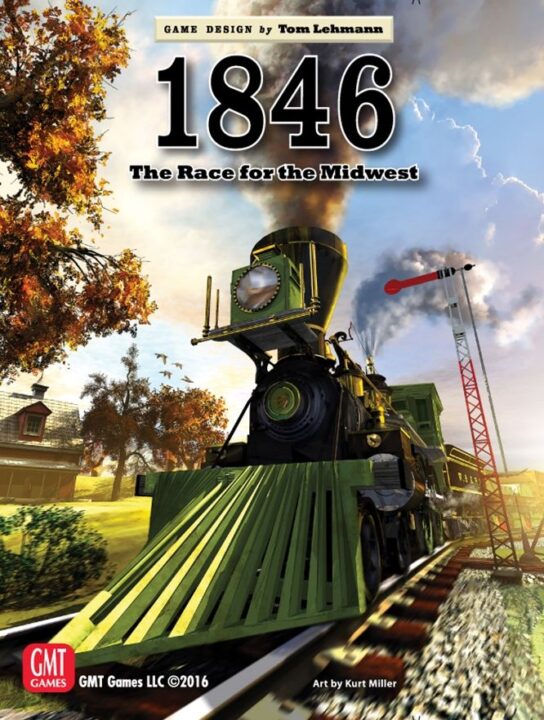Overview
Welcome to the verdant plains and thriving cities of ‘1846: The Race for the Midwest‘. In this review, we’ll take a journey through the multifaceted experiences this game provides, from the rule complexity to the intricate economic strategies and consequential player interactions. A grand spectacle of engagement and strategy awaits within this locomotive epic, as we uncover whether it deserves a spot in your collection.
How It Plays
Setting Up
In 1846: The Race for the Midwest, setup begins with players choosing their preferred railway corporations and receiving starting capital. The game board is laid out, showing various cities across the Midwest that players will aim to connect with their railway systems. Each player then participates in an initial stock round, purchasing shares to determine the starting President of each corporation and the initial order of play.
Gameplay
Gameplay in 1846 is a blend of stock management and track building. Players take turns operating their railroads, deciding routes, and purchasing trains, while managing their finances both personally and for their respective companies. The shrewd trading and manipulation of these entities’ stocks are crucial, as the interplay between company success and personal wealth leads to dynamic in-game decisions.
Winning the Game
To win, players must master both the railway expansion and the stock market, accumulating the greatest personal fortune by the end of the game. When the bank’s money supply is exhausted, the player with the highest net worth including cash, shares, and trains, claims victory in this economic race across the Midwest.
Want to know more? Read our extensive strategy guide for 1846: The Race for the Midwest.
Navigating the Intricate Rails of 1846
I remember my first encounter with 1846: The Race for the Midwest quite vividly. The rulebook felt like a dense fog over Lake Michigan as I attempted to traverse its initial breadth. This game is a beast in terms of complexity—a -inch-thick rulebook anyone? Yet, transition into the gameplay, and like a locomotive gaining speed, it becomes a thrilling journey of strategy and thought.
Layered Rulebook Exploration
Early confusion soon gave way to appreciation. As each rule interlocked with the next like carefully laid train tracks, the true gameplay depth emerged. Choices abound but are meaningfully constrained by these rules, allowing for a synchronized rhythm between planning and action.
The True Game Depth
As my gaming group and I delved deeper into repeated playthroughs, we discovered layer upon layer of strategic depth, rarely unfolding the same way twice. Each gaming session carved out a unique narrative, chosen strategically by the players guiding their 19th-century empires.
Teasing apart the rule complexity of 1846 often leads to the gratifying realization that amidst these mechanics lie a richness of gameplay experience. Now, let’s stoke the fire and build up steam as we chug over to the next section – examining the game’s competitive economic strategies.

The Economic Chess of 1846
During my playthroughs of 1846: The Race for the Midwest, the cutthroat economic strategies always stand out. One gearing component is the draft for private companies, which acts as a cerebral battleground where players post earn gems or relics that can drastically alter their trajectory. Form my experiences, timing on when to float your companies and which trains to invest in act decisively marched towards victory. It’s like a high-stakes poker game, but with locomotives.
Fine-Tuning the Finance
The beauty of 1846 lies in the ability to refine your finance engine — adroitly balancing income, investments, and interests. Remember when I aggressively pushed for trains only to see my railroad’s financial house-of-cards collapse? Indeed, riches await those weaving economic advantages from their opponents’ strategies.
Monopolistic Maneuvers
It’s not merely about what you do, but also about anticipating your rivals’ moves. Controlling key routes and timing the obsolescence of trains lends a psychological war eternal the participants, intensifying the gameplay. Let’s just say my friends and I have developed entire histories o alliances and feuds born from 1846’s competitive tactics.
Next up, let’s shift tracks and delve into how player interaction and negotiation play pivotal roles in this economic frenzy.

The Social Ties of Railroad Empires
In my experience with 1846: The Race for the Midwest, player dynamics transform the game board into a stage for intricate discussions and bargaining feasts. There’s a potent level of interaction not found in many games, making each session a captivating narrative of alliances and business savvy.
A Mosaic of Negotiations
From auction phases to track development, choices made at one corner of the table invariably ripple across to affect all players. During one heated game, a cunning proposition from another player left our group in a surprising joint venture, which ingeniously shifted the balance of power.
Reading the Room
Playing off each other’s strategies is the bread and butter of 1846. The ability to interpret your friends’ next moves and adjust accordingly is a thrilling aspect of its social play. Each game trains your negotiation finesse and social strategy.
So, would I recommend 1846? Absolutely. For those interested in complex interaction and substantial gameplay value, this game could be your next board-game love affair.

Conclusion
After diving deep into the rules and mechanics, strategizing through the economic challenges, and forging alliances through negotiation in ‘1846: The Race for the Midwest,’ we’ve arrived at the end of our review. This game distinguishes itself with intricate systems that reward careful planning and adaptability. While the complexity may not be for everyone, those who relish a rigorous board game experience will likely find ‘1846’ to be a satisfying endeavor. It taps into the joy of group engagement, nudging players to interact in fundamental and complex ways. So, if your gaming group enjoys heavier games filled with strategy and interaction, ‘1846’ is definitely a sound investment for your collection, bringing depth to your table with each playthrough.


